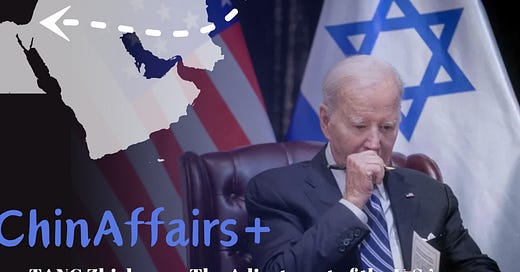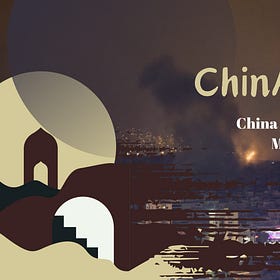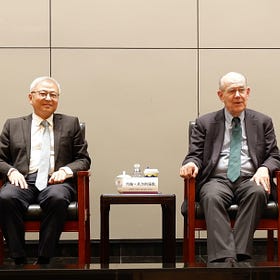TANG Zhichao on The Adjustment of the U.S. Strategy in the Middle East: Environment Shaping and Order Rebuilding
Welcome to the 10th edition of our weekly newsletter! Yuhan Sun and I recently shared our views on the potential for China-U.S. cooperation in artificial intelligence. With both countries as leading powers in tech and innovation, China and the U.S. are uniquely positioned to drive responsible AI development that supports global progress. Read the full article here:
https://www.chinadaily.com.cn/a/202410/29/WS67202ae7a310f1265a1ca170.html
ChinAffairs+ is a weekly newsletter that shares Chinese academic articles focused on topics such as China’s foreign policy, China-U.S. relations, China-European relations, and more. This newsletter was co-founded by me and my research assistant, ZHANG Xueyu. I am SUN Chenghao, a fellow with the Center for International Security and Strategy (CISS) at Tsinghua University, and currently a visiting scholar at the Paul Tsai China Center of Yale Law School in the United States.
Through carefully selected Chinese academic articles, we aim to provide you with key insights into the issues that China's academic and strategic communities are focused on. We will highlight why each article matters and the most important takeaways. Questions or criticisms may be addressed to sunchenghao@tsinghua.edu.cn
Summary
Since the end of the Cold War, successive U.S. administrations have continuously adjusted their Middle East strategy to address shifts in the global landscape, challenges to the U.S. global strategy, and evolving regional geopolitics. The core objective of the U.S. Middle East strategy continues to be the maintenance of U.S. hegemony in the region, aligned with broader U.S. strategic aims.
Currently, shaping the strategic environment at both global and regional levels to compete with China and restrain Russia has become a central priority for the Biden administration in advancing strategic competition among major powers. In the Middle East specifically, the United States' decade-long strategic withdrawal has led to a significant erosion of its dominance, marking the emergence of a “post-American era” in the region.
China and Russia, recognized as the U.S.'s primary global competitors, along with the regional challenger Iran, are expanding their influence, while the U.S.’s key allies and partners increasingly express concerns about its reduced presence. This shift has encouraged the rise of strategic autonomy in the region, signifying a gradual detachment from U.S. influence. In response, the U.S. has formulated a new Middle East strategy, now primarily focused on strategic competition.
For the first time, a primary goal is limiting the regional influence of China and Russia. This strategy emphasizes rebuilding U.S. regional leadership, reshaping regional norms, renewing alliances and partnerships, reinforcing the regional security framework, and restructuring supply and value chains. The overarching task is reshaping the strategic environment to prevent China and Russia from "filling the power vacuum."
Therefore, the U.S. is strategically engaging in environmental shaping within the Middle East to sustain the American-led order established over the past three decades. Although these initiatives appear innovative, they reflect an "old wine in a new bottle" approach, rooted in Cold War mentalities, bloc politics, and a zero-sum perspective—factors that are unlikely to advance stability or development in the Middle East, casting doubt on the feasibility of achieving these strategic goals.
Why it matters
In the post Cold War era, the strategic environment for the United States in the Middle East continues to deteriorate. Following an increasing dynamic shift in global powers, the United States struggles to maintain its long-standing hegemony in the Middle East. China and Russia's engagement in Middle East affairs and the rise of regional power illustrate a growing multipolarization trend that damages U.S. hegemony. So it is important to pay more attention to how the U.S. deals with this situation.
Amidst the complex and shifting dynamics of power competition, Biden administration has put more emphasis on the Middle East, aiming at reshaping its strategic environment in this crucial area and protecting its regional interests. The author explained the U.S. Middle East strategy in detail. Also he analyzed the difficulties faced by the U.S. in regaining influence in the region, both domestically and internationally. These insights are essential to understanding the prospects for both conflicts and cooperation in the post-America Middle East where diverse actors compete and collaborate across economic, political, and technological spheres. Against the backdrop of 2024 U.S. presidential election, the author's opinions can provide us with new insights into the future of U.S. Middle East strategy.
Key Points
Changes in U.S. Middle East Strategy in the Context of Global Hegemony Competition
Entering the post-Cold War era, the Middle East shifted from U.S.-Soviet bipolarity to a U.S.-dominated phase. Over 30 years, regional dynamics evolved due to changing regional power balances, transformations in international relations, and shifts in U.S. influence—transitioning from the “America moment” to the “post-America era”.
Seeking to Construct a “New Middle East Order” (1991-2001): The collapse of the Soviet Union marked the beginning of a unipolar U.S.-led order in the Middle East. During this period, the U.S. established itself as the primary power, enforcing sanctions on previous Soviet allies and initiating peace negotiations, such as the 1990 Madrid Peace Conference, between Israel and neighboring Arab countries. However, in the meantime, the removal of all other actors created a political and ideological vacuum that led to the rise of political Islam and extremist ideologies.
Promoting the “Greater Middle East Initiative” (2001-2010): In response to the 9/11 attacks, the U.S. under the leadership of President Bush launched the “War on Terror,” leading to invasions in Afghanistan and Iraq and efforts to reshape the Middle East through democratization. This period led to a direct expansion of U.S. influence, but its main effect has been to heighten the regional sectarian tensions and created security imbalances. The initiative not only failed to achieve its main objective of long-term stability, but also embroiled the U.S. in costly military conflicts.
Implementing Strategic Retrenchment (2010-2020): With the Obama administration’s “Pivot to Asia” and Trump’s policies, the U.S. began to step back from the Middle East, aiming to reduce its commitments and focus on Asia-Pacific priorities. This period saw regional uprisings, the realignment of regional powers leading to the formation of multiple confrontational small multilateral camps around regional hotspot issues, which weakened traditional power structures. As U.S. influence declined, Russia expanded its role in the region. Based on what mentioned above, the Middle East entered into a post-American era.
Shaping the U.S. Middle East Strategic Environment in the Context of Great Power Competition
The Biden administration has reassessed global and domestic conditions, concluding the post-Cold War era has ended. It views strategic competition with China and Russia as a struggle to reshape the international order, necessitating a U.S. focus on great power competition to constrain and alter Chinese and Russian policies.
Rethinking the Role of the Middle East in America's Global Strategy: The Middle East is a region that profoundly reflects the changes unseen in a century. In this sense, the U.S. Middle East strategy faces great challenges. Fundamentally, the Biden administration faces not a checklist of individual challenges, but a systemic challenge compounded by various factors and multiple issues. This includes the dramatic changes in the strategic environment that the U.S. faces in the Middle East, as well as the historic adjustments in the regional landscape. To succeed in great power strategic competition, the U.S. believes it must shape a new strategic environment in the Middle East and rebuild the regional order. So Biden administration has systematized and solidified great power strategic competition, positioning China and Russia as the primary rivals in global strategic competition, while reaffirming that the United States has significant political, economic, and security interests in the Middle East region.
Focusing on reshaping of the regional environment of the U.S. Middle East strategy: Biden administration has regarded strategic competition with China, Russia and Iran as the core of its Middle East strategy. The U.S. aims to eliminate threats from the Middle East while creating opportunities for cooperation with regional countries, countering the expanding influence of China and Russia in the region, and ultimately restoring the U.S.-led order in the Middle East.
Implementing strategic actions across multiple fields to contain the influence of China and Russia in the region: Since taking office, the Biden administration has made a series of important deployments and introduced significant measures centered around great power strategic competition. These include rebuilding U.S. leadership in the Middle East, reshaping regional order and rules, reconstructing regional partnership, reshaping value and supply chains and reestablishing security systems dominated by the U.S..
The Challenges of U.S. Middle East Strategy Amid the Accelerated Evolution of the Middle Eastern Order
Despite Biden's many new efforts to introduce a Middle East "New Deal," the U.S. Middle East strategy now faces multiple challenges, and the strategic environment has not developed as expected.
The Biden administration's new Middle East policy has significant flaws. First, the difficulties of Biden's rebalancing between the Asia-Pacific, Europe, and the Middle East is substantial. Second, the U.S. government lacks the resources and capabilities to advance its promised major initiatives. Third, Biden's new Middle East policy has reverted to old approaches, centered around self-interest, falling into the paradox of ideals versus reality. Fourth, the imbalance and unfairness of Biden's policies make it difficult to gain support from regional countries. Fifth, Biden's Middle East strategy is inherently contradictory, which is bound to produce counterproductive effects.
The U.S. hegemonic strategy in the Middle East struggles to resist the prevailing changes in the regional order. On the one hand, the U.S. is increasingly heading toward relative decline, with its Middle East strategy continuously failing and its policy of strategic withdrawal from the region leading to a significant decrease in influence, control, and shaping capacity in regional affairs. The U.S. reputation in the Middle East has been repeatedly damaged, and the tendency of regional countries to distance themselves from the U.S. is becoming more pronounced. The U.S. has limited tools to conduct strategic competition against China and Russia in the Middle East, making it a challenging endeavor. On the other hand, in response to the U.S. and Western efforts to restrain China and Russia in the Middle East, both countries will not remain passive or inactive.
The strategic autonomy awareness of regional countries challenges the great power competition strategy that the U.S. seeks to implement in the Middle East. The strategic autonomy of Middle Eastern countries is dual-faceted, as it reflects both the desire to take charge of their own affairs and the insistence that regional matters should be determined by regional states themselves, opposing external interference and control. In an era of great power competition and increasing global diversification, the status of regional powers and middle powers has significantly risen, leading to greater autonomy and flexibility in their foreign policy. The push for economic diversification, however, also fosters regional cooperation, as countries may find common ground in projects that address mutual trade and investment interests.
Conclusion
Reviewing the evolution of U.S. Middle East strategy since the end of World War II, although policies have continually adjusted, some core elements have remained largely unchanged. First, it always serves and subordinates to America's global strategy. Second, it considers the protection of Israel's security as a core interest of the United States in the Middle East. Third, it ensures the supply of energy from the Middle East to the U.S. and the West. Fourth, it relys on the establishment of military bases and the formation of regional alliances and partnerships to maintain U.S. interests and regional hegemony. But it is evident that the U.S. regional strategy is characterized by selfishness, hegemony, and a tendency towards conflict, which has failed to bring stability and prosperity to the region. The strategy will get worse in the future, and Biden's efforts to reshape the strategic environment in the region have become an illusion.
About the Author
Tang Zhichao 唐志超:Dr. Tang is the Director of the Department of Political Studies and the Middle East Development and Governance Research Center at the Institute of West Asian and African Studies, Chinese Academy of Social Sciences (CASS). His research focuses on Middle Eastern politics and international relations, Middle Eastern security, China-Middle East diplomacy, Turkish studies, and the Kurdish issue. Tang also holds several academic roles, including Member of the Academic Committee at the Institute of West Asian and African Studies, Vice President and Secretary-General of the Chinese Society of Middle Eastern Studies, and Professor at the School of International Political Economy, University of the Chinese Academy of Social Sciences. He holds a Ph.D. and is a Research Fellow.
About Publication
The Chinese version of the article was published by West Asia and Africa(《西亚非洲》). The academic journal founded in 1980, is published by the Institute of West Asian and African Studies at the Chinese Academy of Social Sciences (CASS). West Asia and Africa emphasizes in-depth exploration of political, economic, international relations, historical, religious, cultural, and social issues related to the regions of West Asia and Africa, balancing foundational theoretical research with major contemporary issues. The journal highlights research that is theoretical, forward-looking, and innovative. It has long been a prestigious academic resource for Chinese scholars in Middle Eastern and African studies and serves as an essential reference for relevant government agencies, institutions of higher learning, and research organizations engaged in international affairs, as well as professionals in foreign trade and market analysis. West Asia and Africa is listed as an A-rated journal in the AMI evaluation of Chinese humanities and social sciences journals, a CSSCI source journal by Nanjing University, and a core journal in Chinese by Peking University.
#1 China Scholar Insights:Conflict in the Middle East
Welcome to the first edition of China Scholar Insights!
YAN Xuetong & John Mearsheimer Conversation: Who Shapes Global Order, and Who Will Win the Competition?
On the afternoon of October 11, 2024, John Mearsheimer, renowned American realist and professor of political science at the University of Chicago, engaged in a discussion with Yan Xuetong, dean of the Institute of International Relations at Tsinghua University, on the topic of "Global Order and China-U.S. Relations." This marked their third debate, foll…










